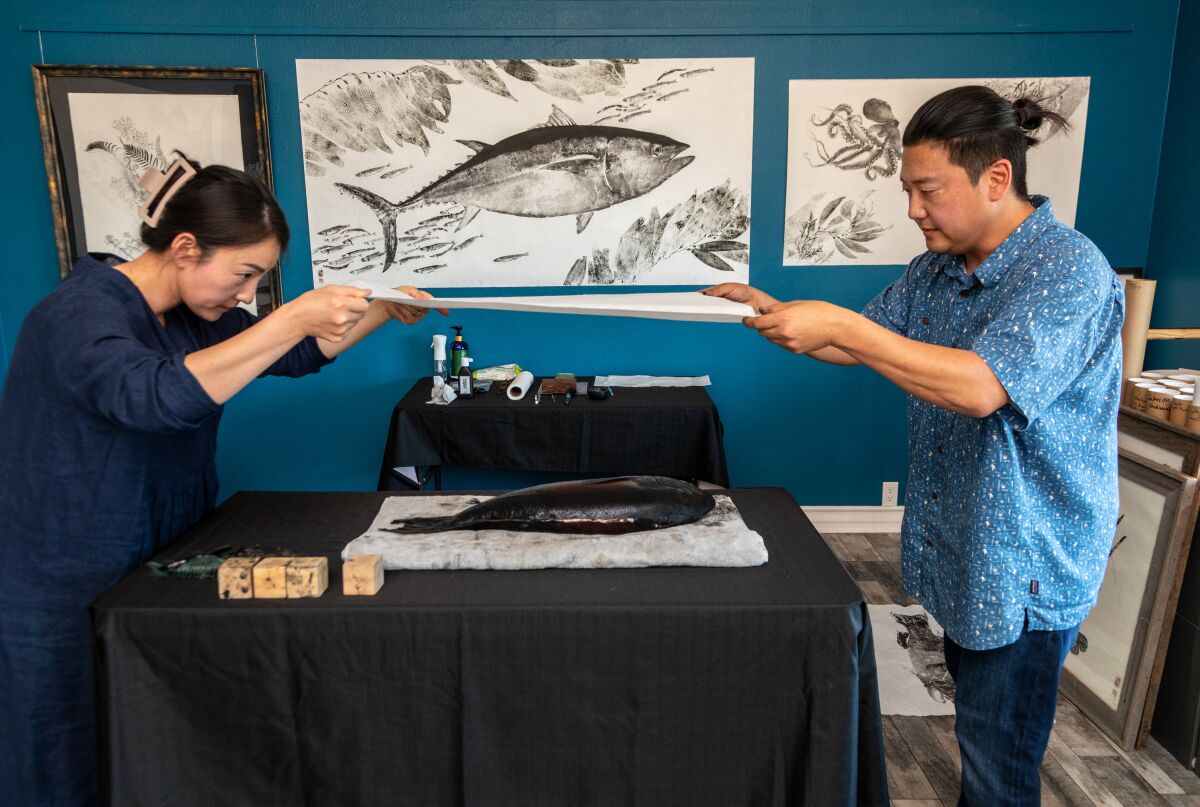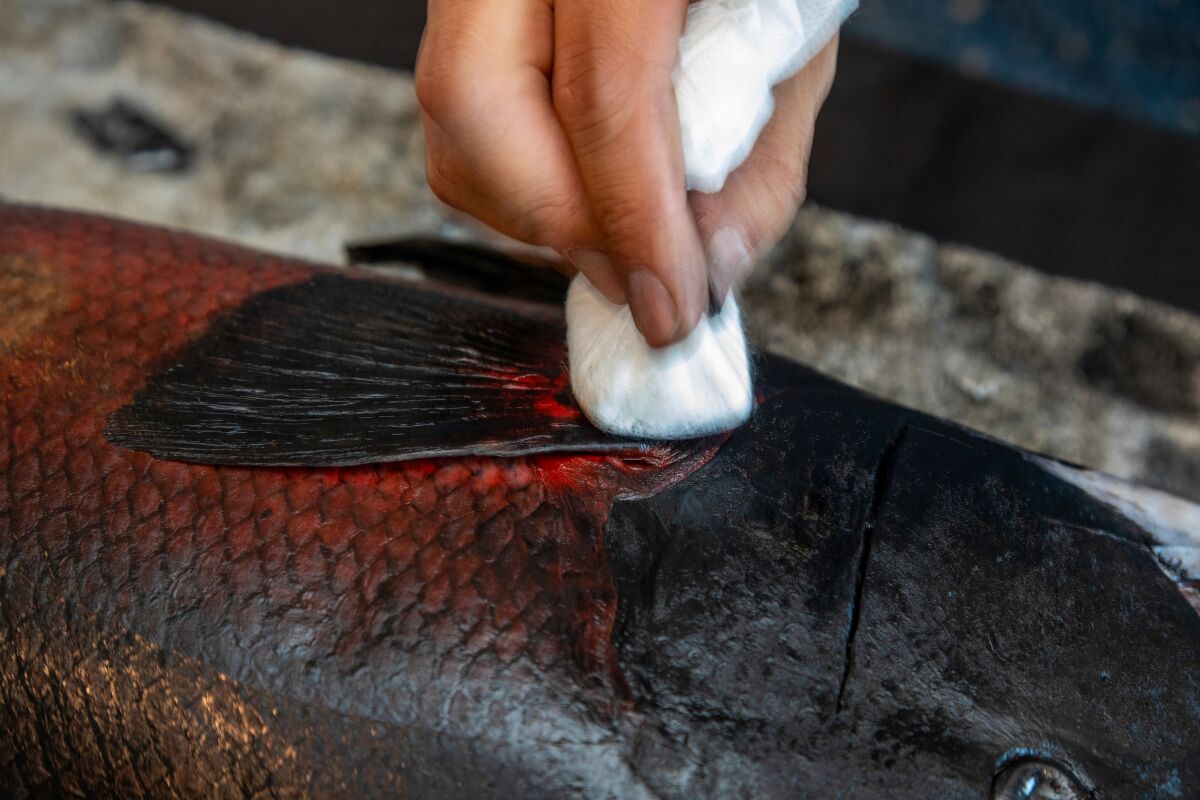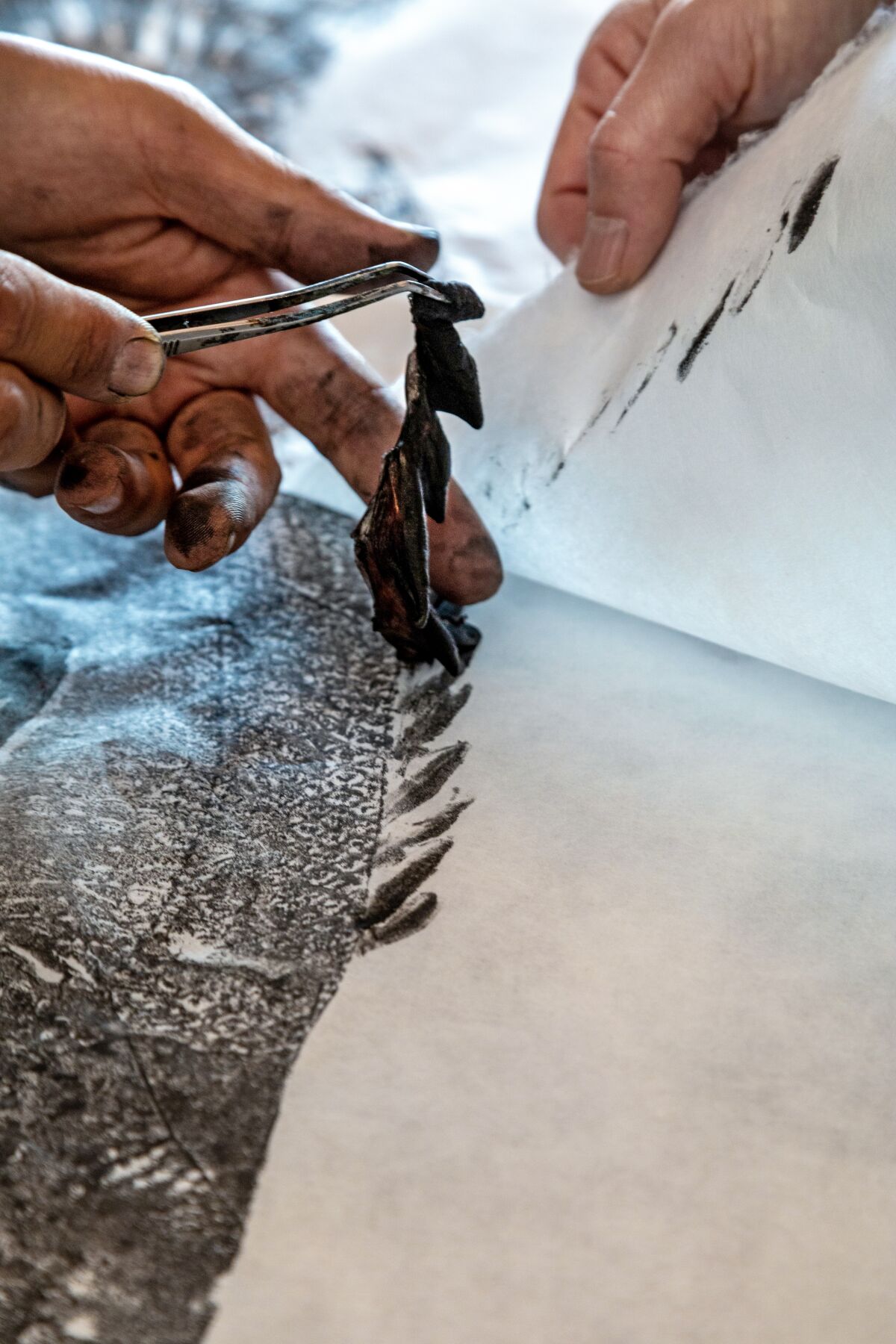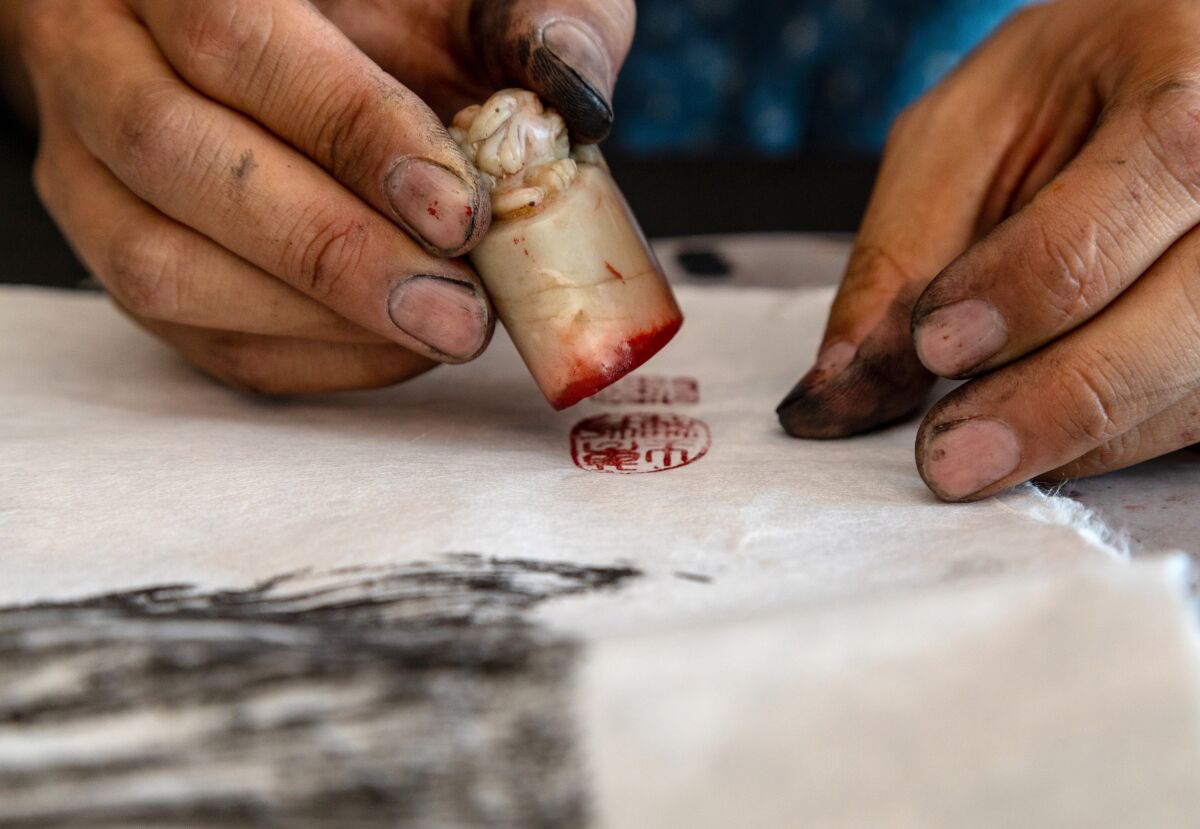After gently putting the rockfish onto the desk, Dwight Hwang paints the highest layer of fish with a light-weight layer of onyx Japanese sumi ink. Subsequent, he fastidiously presses a fragile sheet of washi (mulberry paper) over the fish’s scaly floor to make a print in a video for Positively Groundfish, a nonprofit educating customers about West Coast fisheries.
“It’s basically the Japanese model of taxidermy,” says Hwang, a Korean American artist and fluent Japanese speaker, in regards to the Japanese artwork type of gyotaku — “fish rubbing” in Japanese — a approach that native fishermen would commemorate their catches earlier than consuming the fish. “Pictures was restricted, and this Nineteenth-century follow is a faithfully recorded doc.”
The artwork kind is easy however tough to grasp. First, paint one facet of the fish with sumi ink, place washi paper atop, then use your fingers to press over the floor to make a print. Hwang sticks to a few conventional elements to stay devoted to the classical approach he’s lovingly borrowed from one other tradition: “the ink, the paper, and the fish” and restricts himself from fixing errors or including elaborations moreover portray within the eye. His deceased fish fashions are largely sourced from fishmongers and business captains equivalent to Rex Ito at Primetime Seafood and Tommy Gomes.

Dwight Hwang, helped by his spouse, Hazel, lowers a bit of calligraphy paper onto a sheephead that has been painted with ink.
(Ricardo DeAratanha / Los Angeles Occasions)

Dwight Hwang paints a sheephead with ink.
(Ricardo DeAratanha / Los Angeles Occasions)
His marine-focused artwork has gained followers amongst restaurateurs, artwork collectors and motels such because the 4 Seasons Sensei Lanai in Hawaii and Wynn Las Vegas. By means of his work, he shares his ardour for the ocean and highlights the Japanese cultural love and admiration for easy, fleeting pleasures whereas sparking conversations in regards to the vulnerability of marine life as a result of human interference and our altering oceans.
“I really like something fish associated; it’s how I’m wired,” says Hwang. Throughout a seven-year stint in Tokyo as a movie storyboard artist, he was excited to find gyotaku prints displayed in sushi eating places and sort out outlets. He grew to become obsessive about the artwork kind, studying methods in his free time from YouTube movies. “It took about three years for me to lastly get one thing that regarded like a fish,” he stated. “That’s when it began to get thrilling.”
Discovering this new ardour made him notice that after working for greater than 20 years within the film business, he was burnt out and infrequently noticed his child. After his spouse, Hazel Hwang, persuaded him to pursue gyotaku as a profession, his first consumer was Patagonia, which bought his “Trout Leaping In the direction of Dragonfly” piece for the e book cowl of “Easy Fly Fishing” in 2018.
Hwang’s naturalistic paintings reminds the fly-fishing reader to be extra “conscious that fishing isn’t doable with no wholesome river system,” says Karla Olson, books writer at Patagonia. “We would like readers to acknowledge the necessity to defend the locations the place they play — a lot of that are underneath risk.”
That first piece led to a multicity tour instructing gyotaku workshops at Patagonia shops, exposing new audiences to the artwork kind. In Toronto, Hwang collaborated with native marine biologists and activists to spotlight an epidemic of “salmon milking,” by which migrating feminine salmon are killed for his or her eggs. “I noticed footage of salmon carcasses with bellies ripped open, littering native riverbanks, parks and trails. Patagonia wished us to print certainly one of these desecrated salmon in entrance of an viewers,” says Hwang.
That salmon was robust to print, with bloody uncovered wounds and guts. With the assistance of his spouse, he printed the fish from a bottom-angled perspective to spotlight the reduce stomach, which is extra complicated than the standard strategy of printing the flattest facet of the fish. The ensuing piece is haunting; the fragile black and white fish deformed with jarring splotches of dangling brown guts.

Dwight Hwang, lifts the dorsal fin of a sheephead as he applies the inked marking.
(Ricardo DeAratanha / Los Angeles Occasions)
Different instances, his artwork is extra uplifting, as with a print of California’s critically endangered large sea bass.
“The paintings begins a beautiful dialogue, not solely due to its endangered standing however for the superb conservation work,” says Hwang.
That conservation work has helped large sea bass numbers rebound a lot since 2004, once they have been first listed as critically endangered by the Worldwide Union for Conservation of Nature and Pure Sources, that some marine researchers have really useful reevaluating their standing.
“I attempt to work with artists like Dwight who can translate our information in a approach that’s accessible,” says Sarah L. Mesnick, ecologist on the Nationwide Oceanic and Atmospheric Administration’s Fisheries division Fisheries, who collaborates with artists to create instructional and outreach supplies. “Scientists can let you know about sardines, anchovy and mackerel, but it surely’s only a lengthy record of names and information. By coupling our scientific work with artists, we will transmit messages in a format the general public finds enjoyable and interesting, so I see artwork as a bridge between science and the general public.”
Hwang made a very visceral piece in collaboration with scientists in 2022 after a uncommon and monstrous angler fish washed up in Newport Seashore. There are solely about 30 specimens in collections worldwide, however this was the third time one had appeared on a seashore in California in a few years.
“The fish is weird, each cute and demonic, and the feel feels such as you’re dipping your arms into jello coated in cactus spines. It’s actually bizarre, and printing it’s significantly difficult; it’s as if the fish doesn’t wish to be printed,” says Hwang.
His work was displayed on the Pure Historical past Museum of Los Angeles County, inspiring dialogue about why the anglerfish retains washing up in California. “It additionally brings up the huge mysteries of the ocean and the world, reminding us that there’s a bigger world of organisms moreover us,” says Hwang.
In addition to the riddles of the ocean, Hwang’s work usually hits nearer to the center, as when he and his spouse went to La Jolla to print the attention of a deceased dolphin calf, which appears just like a human eye.

Dwight Hwang stamps his signature on certainly one of his artwork items.
(Ricardo DeAratanha / Los Angeles Occasions)

Dwight Hwang pauses with a few of his gyotaku artwork.
(Ricardo DeAratanha / Los Angeles Occasions)
At a Santa Barbara Maritime Museum exhibit that includes the attention print in 2019, Hwang noticed guests discussing the calf’s loss of life. “Some mourned the child dolphin, however loads of people associated to the mom, who has to dwell with the reminiscence of her child’s loss of life,” says Hwang.
Though his work is supposed to remind viewers to worth life’s fleeting moments, it’s additionally reoriented his personal priorities.
“I’m my very own boss and spend 24-7 with my spouse and child, an enormous distinction from being on units from 12 to 16 hours per day,” Hwang says.
His 10-year-old son Weston can also be well-versed in gyotaku. “Throughout public demos and workshops, he’s proper subsequent to me, serving to out and advising,” Hwang says. “I couldn’t ask for something higher.”

